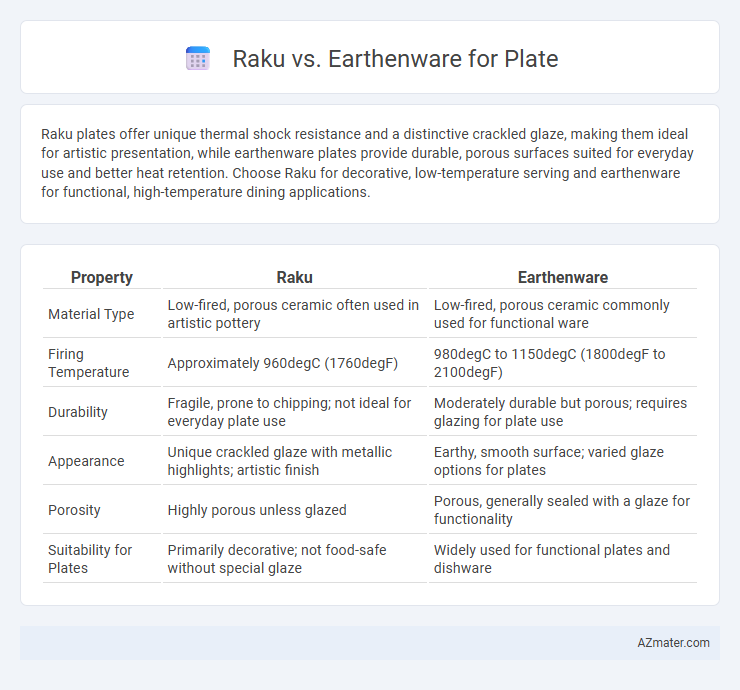Raku plates offer unique thermal shock resistance and a distinctive crackled glaze, making them ideal for artistic presentation, while earthenware plates provide durable, porous surfaces suited for everyday use and better heat retention. Choose Raku for decorative, low-temperature serving and earthenware for functional, high-temperature dining applications.
Table of Comparison
| Property | Raku | Earthenware |
|---|---|---|
| Material Type | Low-fired, porous ceramic often used in artistic pottery | Low-fired, porous ceramic commonly used for functional ware |
| Firing Temperature | Approximately 960degC (1760degF) | 980degC to 1150degC (1800degF to 2100degF) |
| Durability | Fragile, prone to chipping; not ideal for everyday plate use | Moderately durable but porous; requires glazing for plate use |
| Appearance | Unique crackled glaze with metallic highlights; artistic finish | Earthy, smooth surface; varied glaze options for plates |
| Porosity | Highly porous unless glazed | Porous, generally sealed with a glaze for functionality |
| Suitability for Plates | Primarily decorative; not food-safe without special glaze | Widely used for functional plates and dishware |
Introduction to Raku and Earthenware Plates
Raku plates feature a distinctive firing process originating from Japanese pottery, characterized by rapid heating and cooling that creates unique crackled textures and smoky finishes. Earthenware plates, made from porous clay fired at lower temperatures, offer durability and a rustic appearance, often glazed for food safety and decorative appeal. Both Raku and earthenware plates emphasize artisanal craftsmanship, with Raku prized for its expressive surface effects and earthenware favored for everyday usability.
Historical Background and Origins
Raku pottery originated in 16th-century Japan, associated with the tea ceremony and characterized by hand-shaped forms and rapid, low-temperature firing techniques that produce unique glaze effects. Earthenware dates back to ancient civilizations such as Mesopotamia and Egypt, featuring porous clay fired at lower temperatures, making it one of the earliest forms of ceramic technology used for everyday pottery and plates. The cultural significance of Raku lies in its connection to Zen aesthetics and imperfection, while earthenware emphasizes utility and widespread historical usage across diverse cultures.
Material Composition and Properties
Raku plates are crafted from porous, low-fire clay with a glaze that undergoes rapid cooling, producing crackled textures and increased thermal shock resistance, ideal for decorative use. Earthenware plates consist of fired clay with higher porosity and less durability, typically glazed to enhance water resistance but remain more fragile and prone to chipping. The distinct material composition results in raku being favored for artistic expression while earthenware suits everyday functional purposes due to cost-effectiveness and ease of production.
Firing Techniques: Raku vs Earthenware
Raku firing involves rapid heating and cooling, typically removed from the kiln while glowing hot, creating unique crackle patterns and metallic effects on the plate's surface. Earthenware firing is a slower, lower-temperature process, usually fired in an oxidizing atmosphere between 1,000degC and 1,150degC, resulting in a porous and less vitrified finish ideal for decorative plates. The intense thermal shock in Raku produces unpredictable textures, whereas earthenware offers more consistent and durable results suitable for everyday use.
Durability and Strength Comparison
Raku plates, created through a rapid cooling process, tend to be more porous and fragile, making them less durable compared to earthenware. Earthenware plates, fired at higher temperatures, exhibit greater strength and resistance to chipping, ideal for daily use. While Raku offers unique aesthetic appeal, earthenware surpasses it in durability and practical longevity for plate applications.
Aesthetic Differences and Surface Texture
Raku plates exhibit a distinctive aesthetic characterized by crackled glazes, smoky patterns, and vibrant metallic finishes achieved through rapid cooling and post-firing reduction techniques. Earthenware plates, in contrast, typically feature matte or glossy surfaces with uniform, warm earthy tones and smoother textures due to low-temperature firing and porous clay bodies. The tactile quality of Raku is often rougher and more varied, providing a dynamic visual and sensory experience, while earthenware prioritizes consistency and traditional rustic charm.
Functional Suitability for Everyday Use
Raku plates, characterized by their porous and often fragile nature due to low firing temperatures, are less suited for everyday use because they can absorb liquids and may crack with thermal shocks. Earthenware plates, though also porous, are typically glazed to improve durability and resist stains, making them more practical for daily dining. Earthenware's ability to withstand regular washing and varied temperatures enhances its functional suitability compared to the more delicate, decorative Raku plates.
Safety and Food Compatibility
Raku plates often undergo a unique firing process that can leave the surface porous and less sealed, potentially harboring bacteria and making them less ideal for direct food contact without a proper food-safe glaze. Earthenware plates are generally made from clay fired at lower temperatures, resulting in a porous texture that requires a durable, lead-free glaze to ensure safety and food compatibility. Both materials demand careful selection of non-toxic, food-safe finishes to prevent contamination and provide safe dining experiences.
Cost and Accessibility
Raku plates typically cost more due to their labor-intensive, handcrafted firing process that requires specialized kilns and artisans, making them less accessible to casual buyers. Earthenware plates are generally more affordable and widely available, produced using standard ceramic techniques suitable for mass manufacturing. This accessibility and lower price point make earthenware a practical choice for everyday use compared to the artisanal and often collectible nature of raku ceramics.
Choosing the Right Plate for Your Needs
Raku plates offer unique, crackled textures and vibrant glazes ideal for decorative or occasional use, while earthenware plates provide durability, chip resistance, and affordability suited for everyday dining. Consider Raku plates when prioritizing artistic expression and display, as they may be more porous and less suited for heavy use. For practical dining needs demanding sturdiness and ease of maintenance, earthenware plates are the preferred choice.

Infographic: Raku vs Earthenware for Plate
 azmater.com
azmater.com